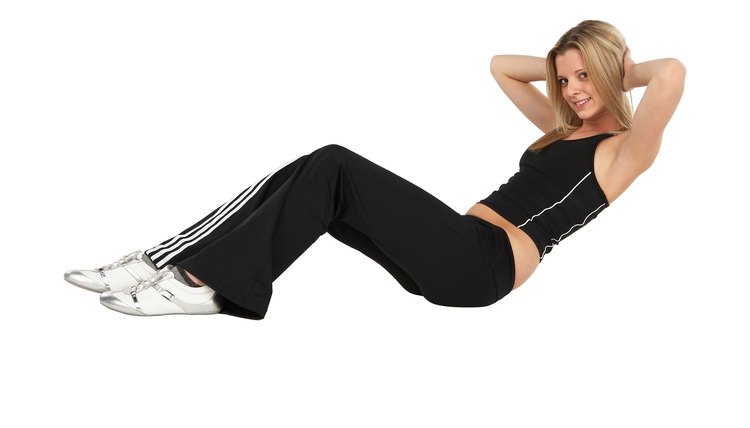Abdominal Internal Oblique Exercises

The rectus abdominis, transverse abdominis, external oblique and the internal oblique make up the abdominal muscles. The internal obliques are located just underneath the external obliques and allow you to bend from the side, as well as twist your torso. These muscles also aid in improving posture. Yoga, Pilates, balance ball workouts, and several core exercises tone and define the internal obliques.
Reverse Twist
Sit down on a fitness ball with feet shoulder-width apart. Walk your feet forward and lean back so that your shoulders and hips are comfortably resting on the fitness ball. Place your hands together and point them toward the ceiling, tighten your core and twist your arms 90 degrees to the left. As you are twisting, your right shoulder should come off the ball. Hold the position for two seconds and return to starting position. Do the same for the opposite side. Do as many as you can comfortably.
Bicycle Crunches
Bicycle crunches tone both the internal and external oblique muscles. Lie on your back and bend legs at a 90-degree angle. Place your hands behind your head and curl your body forward, like you would in a basic crunch. In this position bring your right knee toward your left elbow as you extend your left leg out at a 45-degree angle from the floor. Keep your shoulders lifted off the floor and repeat the crunch with the opposite elbow and knee. Continue alternating from left to right as many times as tolerable.
Side Crunches
Side crunches target the internal and external obliques. Lie on your back with your knees bent. Rotate hips and knees until both knees are turned to the right side and touching the ground. Lift your shoulder blades off the floor and exhale as you come up. Hold the position for one second and lower your shoulders back to starting position. Repeat eight to 15 times, then switch to the opposite side.
Standing Side Bends
This exercise works the internal and external obliques. Adding weights to the side bend challenges the oblique muscles because the weights add resistance. Stand with your feet together, hold a dumbbell by your side in your left hand and place your right hand behind your head. Without twisting or turning your head, bend to the left side using your side abdominal muscles to stabilize yourself. Bend until feel a comfortable stretch in your opposite side. Hold this position for one to five seconds and slowly return to starting position. Do at least eight times, then repeat on the opposite side.
Crunches with Leg Raises
Lie on your back, stretch both arms overhead and straighten your left leg out. The right leg should be bent at the knee with foot on the floor. Exhale and bring your left leg up so your toes point to the ceiling; at the same time crunch forward with your upper body. Attempt to touch the toes of your left foot if you can. Hold the position for one second, then lower body to starting position. Do eight to 15 reps, then switch legs.
Explore In Depth
References
- MayoClinic.com; Core Exercises with a Fitness Ball; Mayo Clinic Staff
- American Council on Exercise: Ab Exercises
- Chang WD, Lin HY, Lai PT. Core strength training for patients with chronic low back pain. J Phys Ther Sci. 2015;27(3):619–622. doi:10.1589/jpts.27.619
- Brumitt J, Matheson JW, Meira EP. Core stabilization exercise prescription, part I: current concepts in assessment and intervention. Sports Health. 2013;5(6):504–509. doi:10.1177/1941738113502451
- Javadian Y, Akbari M, Talebi G, Taghipour-Darzi M, Janmohammadi N.Influence of core stability exercise on lumbar vertebral instability in patients presented with chronic low back pain: A randomized clinical trial. Caspian J Intern Med. 2015;6(2):98–102. PMID: 26221508
Writer Bio
Kimberly Day started writing professionally in 2009. She specializes in creative and technical writing and she authored the novel "Living and Dying." Day holds a Bachelor of Science in communication and business management from East Tennessee State University.
